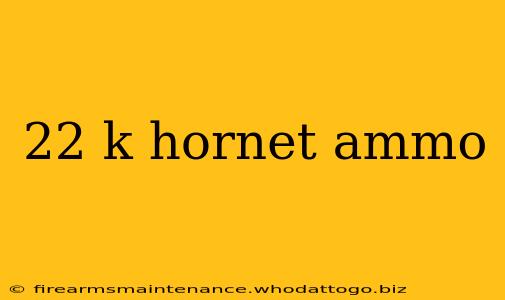The .22 Hornet remains a popular cartridge among hunters and target shooters, prized for its accuracy and manageable recoil. This guide delves into the specifics of .22 Hornet ammo, exploring its various types, applications, and considerations for optimal performance.
Understanding .22 Hornet Ammunition
The .22 Hornet, introduced in 1930, is a relatively low-powered centerfire cartridge known for its accuracy and suitability for small game hunting. Its smaller size and lighter recoil compared to higher-powered cartridges make it an excellent choice for both novice and experienced shooters. However, understanding its limitations is crucial for safe and effective use.
Types of .22 Hornet Ammo
The market offers a diverse range of .22 Hornet ammunition, catering to various shooting disciplines. These variations primarily differ in bullet weight, type, and velocity:
- Hollow Point: Designed for maximum expansion upon impact, ideal for hunting small game, offering humane kills.
- Soft Point: Similar to hollow points but with slightly less expansion, offering a balance between expansion and penetration.
- Full Metal Jacket (FMJ): Primarily used for target practice, these rounds offer greater penetration but less expansion.
- Subsonic: These rounds travel at velocities below the speed of sound, minimizing noise and recoil, making them particularly useful for hunting in areas with noise restrictions.
Bullet weight also varies significantly, typically ranging from 30 to 50 grains. Heavier bullets generally offer better penetration, while lighter bullets provide higher velocities and flatter trajectories.
Choosing the Right .22 Hornet Ammo
Selecting the appropriate .22 Hornet ammo depends largely on its intended use:
- Small Game Hunting: Hollow point or soft point bullets are generally preferred, with heavier grains offering better penetration for larger targets.
- Target Shooting: Full metal jacket rounds are the best choice, ensuring consistent accuracy and reducing wear on the barrel.
- Pest Control: Depending on the pest, a choice between hollow point, soft point, or even subsonic rounds must be made, based on humane kill considerations and noise regulations.
Always check your firearm's specifications to ensure compatibility with the chosen ammunition. Using incorrect ammunition can lead to dangerous malfunctions.
Factors Affecting .22 Hornet Ammo Performance
Several factors significantly impact the performance of .22 Hornet ammo:
- Barrel Length: Longer barrels generally yield higher velocities.
- Powder Charge: The amount of powder directly affects the bullet's velocity and accuracy.
- Bullet Design: As mentioned earlier, bullet type and weight dramatically influence penetration and expansion.
- Environmental Conditions: Temperature and humidity can affect powder burn rate and therefore bullet velocity.
Safety Precautions
Handling any firearm and ammunition requires utmost caution. Always adhere to the following safety precautions:
- Never point a firearm at anything you do not intend to shoot.
- Keep your finger off the trigger until ready to fire.
- Always be sure of your target and what is beyond it.
- Store ammunition in a cool, dry, and secure location, away from children and unauthorized individuals.
- Consult your firearm's manual for specific safety guidelines.
Conclusion
The .22 Hornet remains a versatile and enjoyable cartridge for various applications. By carefully considering the type of ammunition, intended use, and safety precautions, shooters can maximize their performance and ensure a safe and enjoyable shooting experience. Remember to always prioritize safety and follow responsible gun handling practices.

